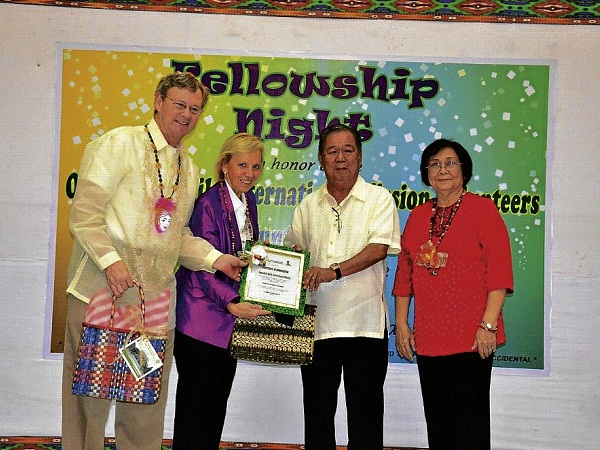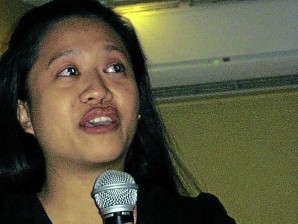A journey home for ‘Operation Smile’ on its 30th mission year

DR. WILLIAM Magee and his wife, Kathy , Operation Smile International Mission founders, receive a plaque of recognition from Gov. Alfredo Marañon Jr. and his wife, Marilyn, at the thanksgiving dinner at the Provincial Capitol Social Hall in Bacolod City on Tuesday night for the Operation Smile volunteers who are into their 19th surgical mission for the cleft palate and lip. CONTRIBUTED PHOTO
Since she was a little girl, May Klaire Parparan has always wanted to become a nurse. But she lost hope when a teenager rudely told her when she was 7 years old: “How can you become a nurse when nurses are beautiful and you’re different?”
“That was when I realized that I was not like the others. My world fell apart. I lost my dream. There did not seem to be a future for me,” she said.
May Klaire was born with a cleft lip, but she never paid attention to her deformity. She always felt special and loved by her family, until she heard the teenager’s remarks.
At age 5, she underwent surgery but it failed to fix the deformity.
In 1994, surgeons from Operation Smile went to Bacolod City, 78 kilometers from her hometown in Isabela, Negros Occidental. May Klaire, then 12, was one of the lucky child beneficiaries of the medical mission.
Article continues after this advertisementTraces of her deformity were removed, and since then, her life has changed for the better.
Article continues after this advertisement“I became more confident. My self-esteem grew. I discovered my self-worth and respected myself more so others would respect me, too,” she said.
Her self-confidence helped her achieve her dream of becoming a nurse.
Now 30, May Klaire is a registered nurse working as a volunteer at Ignacio Arroyo Memorial District Hospital in Isabela. She is one of 2,628 patients whose lives have been changed by Operation Smile since it began its work in Negros Occidental in 1988.
Operation Smile provides free surgeries to repair cleft palate, cleft lip and other facial deformities of children in the country. The Negros Occidental mission is being undertaken for nine days in coordination with the Hope Volunteers Foundation.
A total of 150 children had been scheduled to be operated up to Nov. 17 at Teresita L. Jalandoni Provincial Hospital in Silay City, Negros Occidental.
Among them are 6-year-old twins, Dhesa and Dhea Rodriguez, who are daughters of a truck driver from Barangay Cabadiangan in Himamaylan City, also in Negros Occidental.

MAY KLAIRE Parparan, a registered nurse, was 12 years old when her cleft lip was repaired by Operation Smile’s surgeons. Carla P. Gomez
In 2009, Operation Smile operated on the twins’ cleft lips. On Wednesday, they underwent surgery anew, this time for cleft palates.
Edith Villanueva, Hope vice president and overall coordinator of the mission, said 230 patients with deformities from the 305 applicants had been screened. But only 150 could be accommodated, she added.
Operation Smile started in Naga City in Camarines Sur in 1982. Dr. William Magee and his wife, Kathleen, who are from Virginia State in the United States, traveled with a group of volunteers to Naga for what was supposed to be a one-time mission to repair children’s cleft lips and palates.
But the couple noted so many more with deformities who needed help, so their work became the world’s largest volunteer-based medical charity dedicated to providing free cleft surgeries to children in developing countries today.
Operation Smile Philippines Foundation Inc. was registered with the Securities and Exchange Commission on Aug. 18, 1988, as a nonstock, nonprofit organization. It was the very first resource country organization of the Operation Smile International global network.
Some 7,000 volunteers are scattered in 80 countries, staying permanently in 61. A total of 200,000 children have been assisted.
To mark the global celebration of the 30th anniversary of Operation Smile, Robert Manzano, Operation Smile Philippines president and executive director, said a monthlong medical mission would be conducted in nine cities—Koronadal, Naga, Angeles, Silay, Cagayan de Oro, Manila, Dasmariñas, General Santos and Cebu.
Magee acknowledged that when he first came to the Philippines 30 years ago, he did not come solely for humanitarian reasons. He was a young plastic surgeon who wanted to become better at his craft.
In Naga, however, he noticed that so many children needed help and that this had changed his direction and purpose in life. It taught him and those in the team to think with their hearts to make a difference in the lives of others, he said.
“I am 100-percent sure if we had gone to a country other than the Philippines that first year, there would be no Operation Smile,” Magee said.
He pointed out that the warmth, generosity, openness and the beauty of the Filipino people made them want to come back to the Philippines.
To mark the group’s 30th anniversary, Magee said it decided to make “a journey home because the Philippines is the home of Operation Smile.” It was also its way of saying thanks, he added.
“Filipinos have a special gift of warmth, hospitality and openness that tells people— come back and work side by side with us,” he said.
Magee’s wife, Kathleen, a pediatric nurse, said the Philippines gave the Operation Smile volunteers the opportunity to make what was impossible for many possible in order to have new lives.
But there is still a huge backlog of patients. Oral cleft is among the top 12 congenital defects in the country.
Data gathered by Operation Smile showed that one in every 500 or about 4,000 Filipinos are born every year with a harelip, a cleft palate, or both.
At least 10 percent of the cleft children, or 400, die before reaching their first birthday and 12 percent, or 480, do not live past the age of five.
“We want to reach these unfortunate children so we can treat them at an early age,” Manzano said.
Filipinos can help the children by donating P30. “If every Filipino donated P30 to change the lives of children with a deformity in the country, we can stir a revolution,” Magee said.
Others have also started Christmas fundraising drives, Manzano said.
To donate to Operation Smile, one can go to its website at https://philippines.operationsmile.org/how-to-help/donate/ for details, or to send P30, one can key in SMILE to 4483 through Smart and Sun networks.